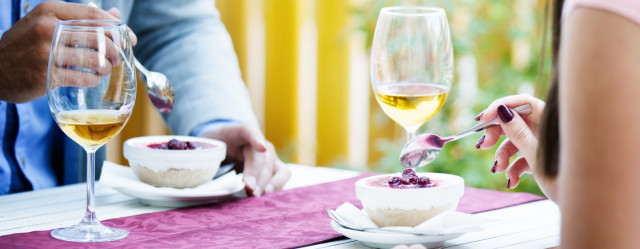Dessert Beers and Wines
Nov. 8, 2021

So you're in the mood for something sweet to finish off your meal? Many people consider dessert wines a go-to at the end of a nice meal, but there are dessert options for beer lovers as well!
What is dessert wine?
In the U.S., the term "dessert wine" means any sweet wine consumed after a meal. Some of the most common types of dessert wines include:
- Fortified Wine
Fortified wines are made by adding distilled spirits during or after the fermentation process. This increases the alcohol content while halting the fermentation process, which lets the wine retain its natural sugars.
Examples: Sherry, Port, and Madeira - Late Harvest Wine
To create late harvest wines, grapes are left on the vine until they get very ripe and sweet.
Examples: Riesling, Muscat, Pinot Gris, and Gewürztraminer - Noble Rot Wine
This wine is made from grapes that have been covered in a mold called botrytis cinerea, a necrotrophic fungus commonly known as "noble rot." The mold removes water from the grapes, which concentrates the sugars, resulting in a super-sweet wine.
Examples: Sauternes, Riesling Auslese
How to choose a dessert wine
Your dessert wine should be sweeter than the dessert you're eating. If it's not, the sweetness of your creme brulee could make your dessert wine taste bitter by comparison. Try pairing the undertones of the wine to the dessert that you're choosing: light fruit and honey flavors will work best with a white dessert wine, whereas with richer chocolate or caramel flavors you may be better off with a darker sweet wine. If you're not sure which wine to choose, port or champagne are good choices, and they pair well with most desserts.
Tip: don't forget the glassware! Dessert wines are served in small glasses for a reason—it allows you to drink slow, tiny sips to savor the flavor of the wine, and it sends the wine toward the back of the mouth and away from the "sweet" tastebuds at the top of the tongue. A 3 oz glass works best for dessert wines.
What is dessert beer?
Less common than its vineyard cousin, dessert beer is darker, stronger, and sweeter than regular beer. Often dessert beers include unusual flavors for a "typical" beer, such as chocolate, vanilla, or cinnamon. Some dessert beers even mimic specific desserts, like Black Forest Cake or Creme Brulee. Dessert beers can also be fruit-inspired, offering hints of peach, pear, or strawberry.
How to choose a dessert beer
Just like with dessert wines, you should choose lighter beers with fruity desserts and more intensely flavored beers to stand up to bold desserts, like chocolate. When you're trying to pair desserts with beer, you're looking for a sweet symphony of flavor that's in perfect balance: the beer should not overpower the dessert, and the dessert should not overpower the beer.
Want some help picking out a great dessert wine or dessert beer? Swing by anytime!
